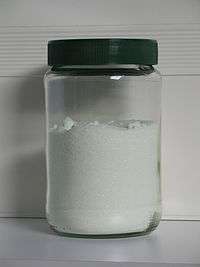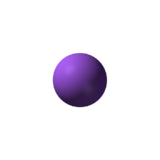Sodium chlorite
| |||
| |||
 | |||
| Names | |||
|---|---|---|---|
| IUPAC name
Sodium chlorite | |||
| Other names
Chlorous acid, sodium salt Textone | |||
| Identifiers | |||
| 7758-19-2 49658-21-1 (trihydrate) | |||
| 3D model (Jmol) | Interactive image | ||
| ChEBI | CHEBI:78667 | ||
| ChemSpider | 22860 | ||
| ECHA InfoCard | 100.028.942 | ||
| EC Number | 231-836-6 | ||
| KEGG | C19523 | ||
| PubChem | 23668197 | ||
| RTECS number | VZ4800000 | ||
| UNII | G538EBV4VF | ||
| UN number | 1496 | ||
| |||
| |||
| Properties | |||
| NaClO2 | |||
| Molar mass | 90.442 g/mol (anhydrous) 144.487 g/mol (trihydrate) | ||
| Appearance | white solid | ||
| Odor | odorless | ||
| Density | 2.468 g/cm3, solid | ||
| Melting point | anhydrous decomposes at 180–200 °C trihydrate decomposes at 38 °C | ||
| 75.8 g/100 mL (25 °C) 122 g/100 mL (60 °C) | |||
| Solubility | slightly soluble in methanol, ethanol | ||
| Acidity (pKa) | 10-11 | ||
| Structure | |||
| monoclinic | |||
| Thermochemistry | |||
| Std enthalpy of formation (ΔfH |
-307.0 kJ/mol | ||
| Pharmacology | |||
| D03AX11 (WHO) | |||
| Hazards | |||
| Safety data sheet | ICSC 1045 | ||
| NFPA 704 | |||
| Flash point | Non-flammable | ||
| Lethal dose or concentration (LD, LC): | |||
| LD50 (median dose) |
350 mg/kg (rat, oral) | ||
| Related compounds | |||
| Other anions |
Sodium chloride Sodium hypochlorite Sodium chlorate Sodium perchlorate | ||
| Other cations |
Potassium chlorite Barium chlorite | ||
| Related compounds |
Chlorine dioxide Chlorous acid | ||
| Except where otherwise noted, data are given for materials in their standard state (at 25 °C [77 °F], 100 kPa). | |||
| | |||
| Infobox references | |||
Sodium chlorite (NaClO2) is a chemical compound used in the manufacturing of paper and as a disinfectant.
Use
The main application of sodium chlorite is the generation of chlorine dioxide for bleaching and stripping of textiles, pulp, and paper. It is also used for disinfection of municipal water treatment plants after conversion to chlorine dioxide.[1]:2 An advantage in this application, as compared to the more commonly used chlorine, is that trihalomethanes (such as chloroform) are not produced from organic contaminants.[1]:25,33 Chlorine dioxide generated from sodium chlorite is approved by FDA under some conditions for disinfecting water used to wash fruits, vegetables, and poultry.[2]
Sodium chlorite, NaClO2, sometimes in combination with zinc chloride, also finds application as a component in therapeutic rinses, mouthwashes,[3][4] toothpastes and gels, mouth sprays,[5] as preservative in eye drops,[6] and in contact lens cleaning solution under the trade name Purite.
Under the brand name Oxine it is used for sanitizing air ducts and HVAC/R systems and animal containment areas (walls, floors, and other surfaces).
Neuraltus Pharmaceuticals is investigating a drug that they refer to as NP001 for treatment of amyotrophic lateral sclerosis. Some people with ALS have concluded that NP001 is a formulation of sodium chlorite, and are ordering the chemical and self-dosing outside of any scientific study. Preliminary results suggest that this sodium chlorite treatment is less effective than NP001.[7] One seller of “Miracle Mineral Solution” (a mixture of sodium chlorite and water also known as "MMS") was recently convicted in the United States for marketing a toxic chemical as a miracle cure, as sodium chlorite cannot be legally sold for human consumption in the country.[8]
Chemical reagent
In organic synthesis, sodium chlorite is frequently used as a reagent in the Pinnick oxidation for the oxidation of aldehydes to carboxylic acids. The reaction is usually performed in monosodium phosphate buffered solution in the presence of a chlorine scavenger (usually 2-methyl-2-butene).[9]
Recently, sodium chlorite has been used as an oxidizing agent to convert alkyl furans to the corresponding 4-oxo-2-alkenoic acids in a simple one pot synthesis.[10]
Acidified sodium chlorite
Mixing sodium chlorite solution with a weak food-grade acid solution (commonly citric acid), both stable, produces short-lived acidified sodium chlorite (ASC) which has potent decontaminating properties. Upon mixing the main active ingredient, chlorous acid is produced in equilibrium with chlorite anion. The proportion varies with pH, temperature, and other factors, ranging from approximately 5–35% chlorous acid with 65–95% chlorite; more acidic solutions result in a higher proportion of chlorous acid. Chlorous acid breaks down to chlorine dioxide which in turn breaks down to chlorite anion and ultimately chloride anion. ASC is used for sanitation of the hard surfaces which come in contact with food and as a wash or rinse for a variety of foods including red meat, poultry, seafood, fruits and vegetables. Because the oxo-chlorine compounds are unstable when properly prepared, there should be no measurable residue on food if treated appropriately.[11][12] ASC also is used as a teat dip for control of mastitis in dairy cattle.[13]
Army
The U.S. Army Natick Soldier Research, Development, and Engineering Center produced a portable "no power required" method of generating chlorine dioxide, known as ClO2, gas, described as one of the best biocides available for combating contaminants, which range from benign microbes and food pathogens to Category A Bioterror agents. In the weeks after the 9/11 attacks when terrorists sent anthrax in letters to public officials, hazardous materials teams used ClO2 to decontaminate the Hart Senate Office Building, and the Brentwood Postal Facility.[14]
Safety
Sodium chlorite, like many oxidizing agents, should be protected from inadvertent contamination by organic materials to avoid the formation of an explosive mixture. The chemical is highly stable in pure form and does not explode on percussive impact (unless organic contaminants are present, e.g. a greasy hammer striking the chemical on an anvil)[15] and will also ignite if combined with a strong reducing agent.
Toxicity
Sodium chlorite is a strong oxidant and can therefore be expected to cause clinical symptoms similar to the well known sodium chlorate: methemoglobinemia, hemolysis, renal failure.[16] A dose of 10-15 grams of sodium chlorate can be lethal.[17] Methemoglobemia had been demonstrated in rats and cats,[18] and recent studies by the EMEA have confirmed that the clinical symptomatology is very similar to the one caused by sodium chlorate in rats, mice, rabbits, and green monkeys.[19]
There is only one human case in the medical literature of chlorite poisoning.[20] It seems to confirm that the toxicity is equal to sodium chlorate. From the analogy with sodium chlorate, even small amounts of about 1 gram can be expected to cause nausea, vomiting and even life-threatening hemolysis in Glucose-6-Phosphate Dehydrogenase deficient persons.
The EPA has set a maximum contaminant level of 1 milligram of chlorite per liter (1 mg/L) in drinking water.[21]
Manufacture
The free acid, chlorous acid, HClO2, is only stable at low concentrations. Since it cannot be concentrated, it is not a commercial product. However, the corresponding sodium salt, sodium chlorite, NaClO2 is stable and inexpensive enough to be commercially available. The corresponding salts of heavy metals (Ag+, Hg+, Tl+, Pb2+, and also Cu2+ and NH4+) decompose explosively with heat or shock.
Sodium chlorite is derived indirectly from sodium chlorate, NaClO3. First, the explosive (only at concentrations greater than 10% in atmosphere) chlorine dioxide, ClO2 is produced by reducing sodium chlorate in a strong acid solution with a suitable reducing agent (for example, sodium sulfite, sulfur dioxide, or hydrochloric acid). The chlorine dioxide is then absorbed into an alkaline solution and reduced with hydrogen peroxide (H
2O
2), yielding sodium chlorite.
General references
- "Chemistry of the Elements", N.N. Greenwood and A. Earnshaw, Pergamon Press, 1984.
- "Kirk-Othmer Concise Encyclopedia of Chemistry", Martin Grayson, Editor, John Wiley & Sons, Inc., 1985
References
- 1 2 EPA Guidance Manual, chapter 4: Chlorine dioxide (PDF), US Environmental Protection Agency, retrieved 2012-02-27
- ↑
- ↑ "New mouthwashes may help take bad breath away" article by Joyce Cohen in USA Today
- ↑ SmartMouth 2 Step Mouth Rinse
- ↑ Skin Deep cosmetic safety database: products containing sodium chlorite,
- ↑ Blink Tears
- ↑ "Frustrated ALS Patients Concoct Their Own Drug" Wall Street Journal April 15, 2012
- ↑ "Seller of "Miracle Mineral Solution" Convicted for Marketing Toxic Chemical as a Miracle Cure". United States Department of Justice. Retrieved May 11, 2016.
- ↑ Bal BS, Childers WE, Pinnick HW (1981). "Oxidation of α,β-unsaturated aldehydes". Tetrahedron (abstract). 37 (11): 2091. doi:10.1016/S0040-4020(01)97963-3.
- ↑ Annangudi SP, Sun M, Salomon RG (2005). "An efficient synthesis of 4-oxo-2-alkenoic acids from 2-alkyl furans". Synlett (abstract). 9 (9): 1468. doi:10.1055/s-2005-869833.
- ↑ Acidified sodium chlorite handling/processing (PDF), Agricultural Marketing Service (USDA), July 21, 2008, retrieved December 9, 2012
- ↑ Rao, Madduri V (2007), Acidified sodium chlorite (ACS), chemical and technical assessment (PDF), Food and Agricultural Organization of the United Nations, retrieved December 9, 2012
- ↑ "Preventing Bovine Mastitis by a Postmilking Teat Disinfectant Containing Acidified Sodium Chlorite" J. Dairy Sci. 90:1201–1208
- ↑ Natick plays key role in helping to fight spread of Ebola Retrieved: 23/01/2016
- ↑ http://pubs.acs.org/doi/abs/10.1021/ie50367a007
- ↑ Goldfrank's Toxicologic Emergencies, McGraw-Hill Professional; 8th edition (March 28, 2006), ISBN 978-0-07-143763-9
- ↑ http://www.poisoncentre.be/article.php?id_article=39
- ↑ Clinical Toxicology of Commercial Products. Robert E. Gosselin, Roger P. Smith, Harold C. Hodge, Jeannet Braddock. Uitgever: Williams & Wilkins; 5 edition (September 1984) ISBN 978-0-683-03632-9
- ↑ Sodium Chlorite - Summary Report of the Europena Agency for the Evaluation of Medicinal Products - Veterinary Medicines Evaluation Unit
- ↑ Acute sodium chlorite poisoning associated with renal failure. Lin JL, Lim PS. Ren Fail. 1993;15(5):645-8. PMID 8290712
- ↑ "ATSDR: ToxFAQs™ for Chlorine Dioxide and Chlorite".




